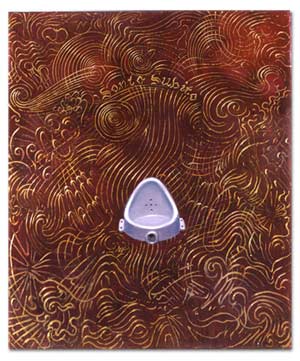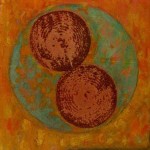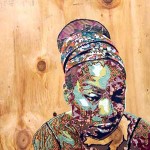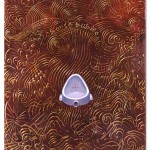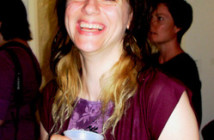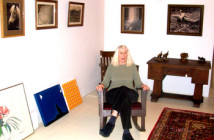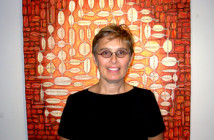Domingo Barreres: “Scales of Spin”
Sue Yang: “Butterfly Series”
Howard Yezerski Gallery
14 Newbury Street
January 6 to February 7
In the work of Domingo Barreres, stretching back several decades, there is always some reference to his native Spanish heritage. In this latest body of work, produced during a sabbatical from teaching at the School of the Museum of Fine Arts, there are vignettes of the “Horrors” and “Capriccios” of Goya, embedded in the paintings as well as references to the tortures of Abu Ghraib, the death of Pope John Paul 11, and Marcel Duchamp’s iconic urinal which he titled “Fountain.”
The paintings are typically complex in both their multi leveled iconography as well as elaborate means of execution. A year ago he discussed them in references to his traumatic responses to the events of 9/11. Initially he produced a body of work which more directly referenced that event and its abstracted images. But he found them too literal and ultimately destroyed them. Or they lay erased and overlaid under the series of panels currently on view. Like countless artists down through the centuries he has struggled with a humanistic urge to respond to horrific events and yet not to do so in an illustrative, propagandistic, polemical manner.
In an artist statement for the exhibition he writes, “The events of September 11, 2001 made it impossible for many artists, including myself, to ignore the potent unleashing of complex emotions, but the two groups of early works I painted in order to come to terms with my inner demons were unsuccessful. Even the technically worst photos taken at Ground Zero would have more visual power. I destroyed these works, but they served to lower the level of poison in my system.”
The key word is that they “lowered” but did not “destroy, resolve or remove” the poisons. As is often the case in the most important works of art the initial raw emotions became filtered and reconfigured into the deeper and more enriched recesses of the psyche. There they festered and irritated the artist who would not be free of them, or have any closure, until they resulted in this compelling and masterful body of work. They only confirm my long standing conviction that Barreres is on the short list of contemporary masters.
There has always been a lot of process in his work. The concoctions of an alchemist, very medieval and Spanish, fueled by the aftershocks of the Inquisition. In another age he would be put to the rack for his many and often witty blasphemies. Like Goya in the late Black Paintings, Barreres indulges brazenly in the dark arts.
To a fresh eye, just wandering into the gallery with no prior knowledge of the work and obsessions of the possessed artist, they present an exotic and Baroque tangle “Swirl” of gossamer lines. Like musical notations, the score of an unfinished symphony, or just cacophony, subjected to the alterations and reconfigurations of photoshop. One suspects these experiments result from his social interactions with neo op painter and friend, Will Mentor, who pursues a similar approach to configuring his swirling, vortex patterned abstractions. But the intentionality of Barerres bears no resemblance of Mentor. They share similar means but toward dramatically different ends.
There in the middle of that gold braided, raised, elaborate decorative lace work, again how “Spanish,” is that impudent urinal. Barreres states that he hoped to recapture its initially repulsive context. Surely when first shown (actually rejected for a group exhibition of avant-garde artists) Duchamp’s found object pissed people off. With time, however, it has become as benign and beloved as a well worn old teddy bear. Hard to imagine that it still has any shock value. But precisely why does Barreres, in this context, reference it? If anything the paintings are richly decorative. More enticing collectables for the complacent bourgeois than matrix of provocation.
Which leads one to ask if perhaps the initial anger of the artist, in the now lost works, has become too refined? The paintings may be too artful and elegant, even though we catch the bite of their vignettes. Are they too elegant and baroque? But this is a process that is not unique to the artist. He begs the question simply because he raises it. Just what is the process by which we refine, abstract and distance ourselves from war and trauma? It evokes yet again the troubling issue of can there be poetry after the Holocaust? Domingo here states that the answer is yes, indeed, this is poetry that allows us to move on with our lives.
By e-mail, the artist added a post script to the review, "The glamourizing role of the gilded web stands for the ornamental rhetoric (spin) that tries (often successfully) to convince ( charm ) us of a certain position despite all evidence to the contrary. 'Fountain' may be lit and displayed as a sacred vessel in sundry museums, but it continues to be a public restroom urinal."
The Project Space features Sue Yang showing with the gallery for the first time. Several years ago I met the artist when she was a student at the Museum School. On that occasion I invited her to show large digital format prints in a then new Project Space series. Later she showed with Nao Projects, which folded several months ago, and subsequently has joined Yezerski Gallery. This new work has grown and evolved from what I first encountered. There is the same concern for repetition of small elements, like shells, marbles and butterflies, with embedded or implied images, that reflect notions of patterning as well as the meditative process of her Buddhist traditions.
“Introductions 2006”: George Rosa, Lorna Williams, and “Triple Threat”: Harvey Loves Harvey
Judi Rotenberg Gallery
130 Newbury Street
January 5 through 28
In 2001, Abigail Ross took over the operation of her mother Judi Rotenberg’s Newbury Street gallery. There was a period of transition and generational change from a rather conservative gallery that focused on decorative, representational painting to take on an ever more progressive and adventurous program. For a time there was an annex upstairs that was the only venue on the Street dedicated to video and installation art. That was abandoned this season but video has been mixed in with exhibitions in the main gallery.
In the past year, as assistant director, Kirsten Dodge, put it during a recent visit and chat, the gallery has really taken off with several of their thirty artists getting a “ton of press” and numerous invitations to show their work. In that regard the current exhibition, a “new talent” presentation in the less that prime, post Holiday month of January features the small, collaged, figurative portraits on carved wood panels by a phenom, the 19-year-old Lorna Williams.
The African American artist from New Orleans is a sophomore at the School of the Museum of Fine Arts. As Kristen would say “there has been a ton of press” including a feature in the Boston Globe Sunday Magazine. The artist lost a home and studio during Hurricane Katrina but has managed to come up with a body of new work. Right now the show is half sold out and going fast at prices that range between $2,500 and $3,500. As one insider put it they are being snatched up by collectors who “missed out when Ellen Gallagher started out here.”
Yes, they are beautiful and compelling pieces. The artist has developed an unique technique of collaging the portraits as mosaics of fragments of found print and material. There are wire lines and edges like the lead in stained glass windows. But she stays true to rendering the images often of jazz themes and views of her friends. It appears that Nina Simone is particularly important to her. And one of her best known songs would be apt to describe Williams “Young, Gifted and Black.” The caveat here is that the artist is terribly young to have such a level of attention. And the works, while compelling, are still modest in scale and ambition.
In their frenzy to cover Williams the critics are unfortunately not reporting on the other artists in this edgy show of new talent. Given a level playing field the collaged and laminated panels of George Rosa would command more interest and ink. He is a recent graduate of the Museum School. I like the work. It combines a hip hop sensibility with superb craft. But they too readily recall the earlier work of another hip hopper Emmett McDermott, who has not shown here since the demise of Zoe Gallery some time ago.
It is not quite accurate to conflate Harvey Loves Harvey with the notion of emerging artists. In fact, the team of Matthew Nash (publisher of Big Red and Shiny) and Jason Dean, who lives in another city, has been rather ubiquitous with conceptual projects. Here they are displaying a grid of photographic triptychs in which they are the protagonists performing charades of famous artist statements. Their show is dubbed ‘Triple Threat” because in addition to showing at Rotenberg they will mount “Machines” at Fitchburg State College, February 8 through March 11, and “Drawings” at the Rhys Gallery in Boston, April 14 through May. Truth is the show should be titled “Quadruple Threat” as they will also show at New England School of Art & Design at Suffolk University this summer. For that project they will add a third collaborator so perhaps in that sense it is not truly a Harvey Loves Harvey project.
Gyorgy Kepes “Paintings and Photographs”
Alpha Gallery
38 Newbury Street
January 7 through February 1
The Hungarian born, Gyorgy Kepes, moved to Chicago after World War Two to help found the New American Bauhaus with Lazlo Moholy Nagy. That effort did not last long and Kepes ended up first at Harvard and then as founder of the Center for Advanced Visual Studies at MIT. There he pursued a long and distinguished career that greatly influenced generations of artists who came to the Center to research, teach and study in the field of art, science and technology.
These experimental interests are best reflected in his experiments with photograms and photography. There are examples of that work in this exhibition that is dominated by his multi media, abstract paintings. The artist often used sand to create lush textured paintings with muted and glowing color. The Alpha Gallery handles the estate of the artist. It is always a treat to view work by this remarkable and influential artist.
This marked my first visit to the new space for the gallery which has just moved down the street. But I was informed that this is the second show in the new venue. The gallery is run by Joanna Fink who took over from her father Alan Fink. It is one of the most distinguished venues for contemporary art. Her mother was the late artist, Barbara Swan, and the gallery also represents her artist brother, Aaron Fink. So congratulations on the beautiful new space and best wishes for continued success.
Links:
Howard Yezerski Gallery
Judi Rotenberg Gallery LLC
Alpha Gallery
All images are courtesy of the artist and their respective gallery.

